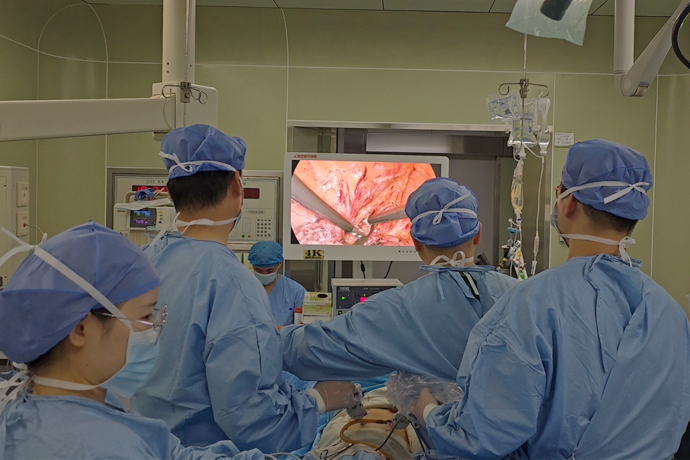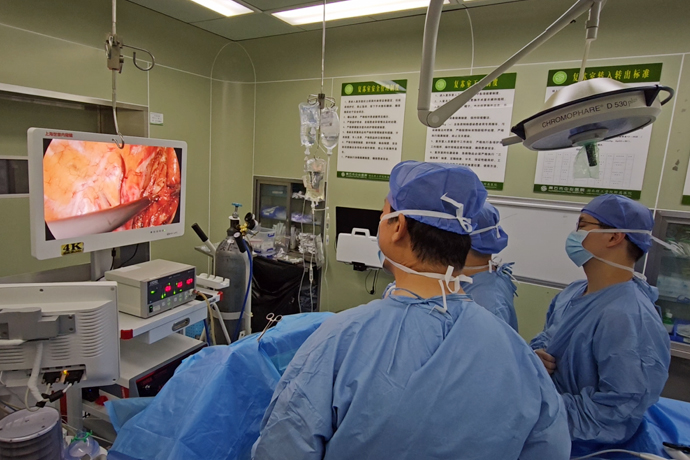[Thoracoscopic surgery of thoracic surgery] 4K ultra-high definition thoracoscopy for esophageal cancer radical resection
Release time: 21 Nov 2023 Author:Shrek
What is minimally invasive surgery for esophageal cancer?
Esophageal cancer is a common malignant tumor, ranking 6th among malignant tumors in the world. my country is a country with a high incidence of esophageal cancer, and its mortality rate ranks 4th. The prognosis is relatively poor, and surgery is the main treatment method. Traditional surgical methods for esophageal cancer mainly include single-incision left thoracotomy surgery, right-sided thoracotomy surgery with two or three incisions, etc. The surgery is invasive, has a greater impact on the patient's cardiopulmonary function, has many complications, and requires postoperative recovery. slow.

Traditional esophageal cancer surgery mainly involves thoracotomy to remove the diseased esophagus. The wound is more than 30 centimeters long, and 1-2 ribs must be cut off. The surgery is invasive, the patient has obvious incision pain after the operation, and it has an impact on the patient's cardiopulmonary function. larger.
Minimally invasive surgery for esophageal cancer is a new surgical method compared to traditional thoracotomy. During the operation, the surgeon needs to use special endoscopic equipment to extend the surgical instruments into the chest through the intercostal space. The chief surgeon uses 4K ultra-high-definition video of the endoscopic Under systematic supervision, surgical operations such as esophageal dissection, tumor resection, and lymph node dissection are completed. With the maturity of surgical techniques and the continuous development of surgical instruments, minimally invasive surgery for esophageal cancer has gradually become the mainstream surgical treatment of esophageal cancer.
Traditional esophageal cancer surgery requires a 20-30cm incision in the chest, and the ribs need to be spread open during the operation to fully expose the surgical area. This will obviously damage the patient's thoracic tissue structure, and the patient will be left with more discomfort after the operation. Obvious incision pain also has a certain impact on the patient's respiratory function.
What are the advantages of minimally invasive surgery for esophageal cancer?
1. It avoids traditional thoracotomy operations such as cutting off the chest wall muscles and stretching the ribs. The operation has small trauma, fast recovery, and can shorten the hospitalization time.
2. Many current studies have shown that minimally invasive surgery for esophageal cancer can significantly reduce the incidence of postoperative atelectasis, lung infection, and arrhythmia.
3. The thoracoscopic surgery system has a magnification function, which can make the surgical field of vision clearer, reduce surgical bleeding, and make intraoperative lymph node dissection more thorough, which can effectively improve the postoperative survival rate of tumor patients.
4. The incision of minimally invasive surgery is beautiful. The surgery only requires several small intercostal incisions of 1-2cm on the chest wall. The advantages of minimally invasive surgery are very obvious in terms of the shape of the incision and the protection of the integrity of the thorax.
5. For some patients with poor cardiopulmonary function and unable to tolerate traditional thoracotomy, minimally invasive surgery for esophageal cancer can give these patients the opportunity to undergo radical surgery.
Surgical position
(1) Prone position on the left side for thoracic esophageal dissection.
(2) In the supine position, the abdominal incision is performed for gastric dissection, and the cervical incision is performed for esophagogastric cervical segmental anastomosis.
Surgical incision
(1) Chest incision: Generally, 4 incisions are used, 1 large incision of 1cm and 3 small incisions of 0.5cm.
(2) Abdominal incision: 5 incisions.
Surgical procedures and coordination
(1) Connect the 4K ultra-high-definition thoracoscope camera system and electric cutting system, use an 11F knife to cut the skin, assist with small curved forceps, wipe the blood with a piece of dry gauze, use a 1cm puncture cannula to establish a mirror hole, and open CO2 to establish a pneumothorax. Create other operating holes in sequence under the guidance of the light source.
(2) Electrocoagulation hook incision of mediastinal pleura
The ultrasonic scalpel releases the right lower pulmonary ligament and frees the esophagus along the spinal level (assisted by a suction device and ordinary endoscopic forceps). If necessary, prepare titanium clips to clamp the branch vessels of the esophagus.
(3) Use ultrasonic scalpel to dissect the lymph nodes of the right recurrent laryngeal nerve chain and cut off the right recurrent laryngeal nerve blood vessels with the assistance of endoscopic ordinary forceps.
(4) Cut off two finger cots from rubber gloves and wash them with talc powder in sterile saline to prepare the specimen for the surgeon.
(5) The azygos vein arch was freed with ultrasonic scalpel and non-injurious grasping forceps, and clamped with 4 titanium clips.
(6) Use the ultrasonic scalpel to free the upper thoracic segment of the esophagus, and prepare ordinary endoscopic forceps, double No. 7 wires, and mid-curved forceps for suspension and traction of the esophagus.
(7) Use ultrasonic scalpel to clean subcarinal lymph nodes, assisted by endoscopic duckbill forceps, and prepare finger cots to remove specimens. At the same time, a titanium clip is prepared to ligate the thoracic duct to prevent chylothorax.
(8) Check that there is no bleeding in the chest, inject the prepared sterile saline into the chest, make sure there is no air leakage in the lungs and bronchi, prepare a 26F bacterium-shaped tube for mediastinal drainage, fix it with a middle triangular needle with No. 1 thread, and connect the drainage bag. After the chest incision is closed, the chest drainage bottle is replaced. At the same time, after the circulating nurse and the equipment nurse have checked the items, they prepare a large round needle with No. 7 thread and a medium triangular needle with No. 1 thread, ready to close the chest.
Postoperative thoughts
1. In terms of diet, no food or water is allowed for 7 days after surgery, because the mucosa at the esophageal anastomosis takes at least 96 hours to heal after surgery, and the nutrients needed by the body require intravenous nutritional supplements. The occurrence of intestinal flatus after 7 days indicates that the gastrointestinal function has basically recovered. You can eat liquid food appropriately, gradually increase the amount, eat small meals frequently, and avoid eating too much, which may cause gastrointestinal flatulence, indigestion, etc. Generally, after 15 days, the type of food can be gradually increased, and the food can still be small and frequent. Under normal circumstances, the normal diet can be resumed in about 2 months, avoiding eating hard and spicy food.
2. Post-mobility. Properly move your limbs in bed the day after surgery to avoid venous thrombosis. If there are no abnormalities, you can get out of bed and move appropriately in about 4-5 days. You can walk around the ward after the sutures are removed.
3. Treatment of complications. Food reflux symptoms may occur when eating, mainly caused by eating too fast. You should slow down your eating speed and tell your doctor at any time if you feel uncomfortable.

- Recommended news
- 【General Surgery Laparoscopy】Cholecystectomy
- Surgery Steps of Hysteroscopy for Intrauterine Adhesion
- [Gynecological Hysteroscopy] Techniques for Preventing and Treating Complications of Hysteroscopic Surgery
- [Gynecological Hysteroscopy] Hysteroscopic Adhesiolysis
- [Gynecological Hysteroscopy] IUD Removal under Hysteroscopy